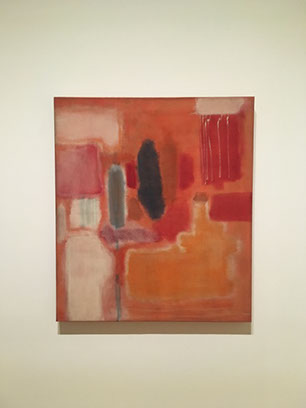Mark Rothko: Subliminal Messages
By Sam Powers
The constant chatter of modern living is something that we all seemingly need to accept as part of our daily life. With the chatter only growing louder as one sensational headline is topped the next day with an even more outrageous one, it becomes difficult to find some quiet time to yourself. When looking for peace and quiet, many turn to art, and there is perhaps none better to turn to than the abstract painter Mark Rothko (1903 - 1970).
Eleven of Rothko’s paintings currently hang on the walls of the Museum of Fine Arts, Boston, in an exhibition titled Mark Rothko: Reflection, and the paintings evoke exactly what the title suggests. The wholly non-objective nature of Rothko’s works intimidates some, which the curator was clearly aware of. The paintings are arranged in a way that eases you into the pure rectangular forms. Starting with an experimental self portrait, the paintings wrap around the room, and as you follow they become increasingly figureless.
No. 9, 1948, oil and mixed media on canvas, National Gallery of Art. © 1998 Kate Rothko Prizel and Christopher Rothko.
No. 10, 1949, oil on canvas, National Gallery of Art. © 1998 Kate Rothko Prizel and Christopher Rothko.
No. 10 (1949) introduces you to Rothko’s style of painting focusing on airy rectangular forms, but the presence of a strong grid gives you structure. There is something familiar to hold onto, keeping you stable while easing into the non-objective world. The curator’s intent becomes clear as No. 9 (1948) echoes No. 10. The painting further familiarizes you with the style but Rothko replaces the rectangles with irregular forms. One more structure is taken away, leaving you more and more on your own with the forms.
No. 1, 1961, oil and acrylic on canvas, National Gallery of Art. © 1998 Kate Rothko Prizel and Christopher Rothko.
Once comfortable with Rothko’s form of non-objective art, No. 1 (1961) is where you must devote your time. The true star of the show, No. 1’s immense size brings the forms to life in a way that is lost on smaller canvases. Here, the rectangular forms become something entirely new. As you stand across from the painting, the size alone is overwhelming enough to force you to stop. The longer you gaze, the slower your breathing gets, the more details you notice: the wispy brush strokes, the slight variations in color, the transparencies between layers. All of this endows the rectangle with life. No longer is it merely a rectangle on a canvas; rather, it becomes a living, breathing form imitating you standing across from it.
In No. 1, Rothko achieves what the art world has been leading up to for centuries. Romanticism, Expressionism, Impressionism: All have been trying to capture the feeling of the sublime. Stripped away from all unnecessary attributes, Rothko distills the sublime to its true essence. There is nothing left but pure feeling. The Suprematist painter, Kazimir Malevich, thought he achieved this feat with his Black Square (1915), but he only expressed a portion of the sublime. He discovered its form, but did not give it life as Rothko does. Where Malevich has hard lines and angles, Rothko has hazy outlines and varied texture. Rothko’s rectangular forms become a window into the sublime, pure feeling, complete with its living, ever expansive, constantly changing nature.
Mark Rothko: Reflection will be showing in the John F. Cogan, Fr. and Mary L. Cornille Gallery at the Museum of Fine Arts, Boston, through July 1, 2018.
Photographs courtesy of author Sam Powers



